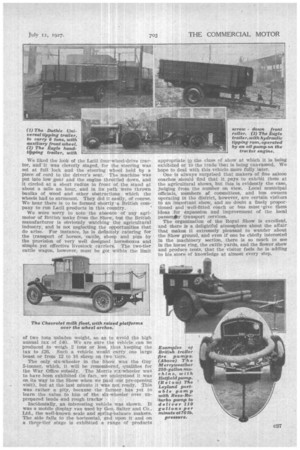THOUGHTS AT THE ROYAL SHOW.
Page 57

Page 58

Page 59

If you've noticed an error in this article please click here to report it so we can fix it.
Some ot the Impressions Gained During a Visit to the Show at Newport on the Opening Day.
FEWpeople attending the Royal Show gave a thought to the labour that was expended in the making of it. Every agricultural show entifils 'on-' usually hard work in getting the heavy exhibits into position, because the show ground is necessarily a field with no made roads, and it gradually gets cut up toan incredible degree, despite the fact that the railway company whose line is to serve the show can always be relied upon for the loan ot a few thousand old • railway sleepers with which to make a hard track between the rows of stands in the implement section. This track is usually two sleepers wide through the main passages, but the covered stands are placed about 30 to 40 feet back, and in the handling of tractors, wagons, plant and machinery into place th,,e margins of the sleeper track become turned into quagmires when much rain is experienced before the show is completed. We were present during three days of the Show's making, and watched some of the feats that had to be performed in order to manceuvre the weightier of the exhibits into position, and we
marvelled at the patience and the ingenuity displayed whenever the difficulties seemed to be nearly insuperable. Scene of the railway elagine.s, for instance, seemed imbued 'with a spirit of obstinacy that foreboded their remaining in the morass 20 feet or 30 feet from the allotted positions, but a few hours of strenuous work on the part of the gangs of workmen with their haulage plant overcathe tile obstinacy, and placed the machines where they were intended to be viewed. It is significant that the road haulage machine was the great standby in this veritable task of Colossus. Without it one wonderet hOW the Show could be made presentable for its opening day.
It Was interesting to see 'that petrel locomotives are steadily advancing into the realm 'of the railroad. The Commercial Motor ha S dealt with many'of 'these developments. This year they: made their appearance at the Royal Show, Fowlers' showing one for a standard gauge track (4 ft. 84 ins.) and Howards one for a 2-ft. track. The Diesel principle has been slow to be *adopted in small units, and is now making distinct progress towards the size suitable for commercial vehicle work. McLarens, of Leeds, have done well to take up the Benz type, which would seem to have proved the better of the two designs, of which the Mercedes-Benz combination found itself in possession when these two important German motor concerns were amalgamated a year or two ago. McLarens have adopted the 60-70 b.h.p. McLaren-Benz engine for a portable ploughing windlass and*for stationary work, and the 30-35 bhp. size for a road roller. The Lanz tractor for road and land work has a semi-Diesel engine. It was shown by the Locomobile Engineering Co., Ltd., and made a good impression. At the next stand to the Lanz ,tractor was shown a Fordson fitted with the Dawe patent wheel, Which was described in The Commercial Motor some months ago. The wheel consists of three annular plates or flat rings, pressed into a sinuous form, the three plates being bolted to a set of spokes to form the tread of the wheel, which, therefore, has a wave _ form which, when the wheel is rotating, presents an increased thrust to the surface of the ground, so that the pulling power is greater with less packing of the soil. We hope to hear that the Dawe wheel has received the Royal Agricultural Society's medal awarded to new implements of outstanding merit.
The steam wagon and steam tractor are steadily fighting against the increased burden of taxation, and it is being countered by efforts towards greater efficiency and longer working range on a tank-load of water, Steam wagons are still too heavy, however, and much could be done by careful redesigning that should get a ton out of the weight of the chassis and should, therefore, permit of the use of the pneumatic tyre. The market for the steam tractor is now being examined by the steam-wagon makers— as, for instance, the Sentinel concern. The big tractor with its 100-h.p. engine built by them for overseas work is a fine example of the excellent designing and workmanship for which the Shrewsbury factory is noted. The boiler has a very large steaming capacity and is of the patented type which presents a series of tubes easy to clean, on which the fuel does not cake, and which seldom calls for replacement.
The trailer in the past year or two has obtained more attention in the drawing office, and the lower load-line, clever, tipping gear and quick-acting coupling controls are qualities now easily obtainable. The new Eagle hydraulic tipping gear for manipulating the load on a tipping trailer drawn by a .Fordson created much comment at the Show. A gear-driven pump driven from the cross-shaft of the Fordson engine and thrown into engagement by a hand-operated clutch, drew oil from a container bolted to the crankcase (the nearby exhaust pipe keeping the oil liquid whatever the weather), and delivered it to the bottom of the main cylinder, thus lifting the body in about 20 seconds. We timed the operation with an empty body, and understand that the makers (the Eagle Engineering Co., Ltd.) claim to be able easily to tip a full load in from 25 to 30 seconds. A control cock When opened permitted the return of the oil to the tank in about 11 seconds. The scheme is well thought out—for example, a spring-loaded valve automatically closes the feed pipe to the ram whenever the trailer is uneoupled from the tractor. Coupling-up automatically opens the valve. We liked the look of the Latil four-wheel-drive tractor, and it was cleverly staged, for the steering was set at full lock and the steering wheel held by a Piece of cord to the driver's seat. The machine was put into low gear and the engine throttled down, and it circled at a short radius in front of the stand at about a mile an hour, and in its path were thrown baulks of wood and other obstructions which the wheels had to surmount. They did it easily, of course. We hear there is to be formed shortly a British company to run Latil products in this country.
We were sorry to note the absence of any agrimotor of British make from the Show, but the British manufacturer is obviously watching the agricultural industry, and is not neglecting the opportunities that do arise. For instance, he is definitely catering for the transport of horses, oattle, sheep and pigs by the provision of very well designed horseboxes and simple yet effective livestock carriers. The two-tier cattle wagon, however; must be got within the limit
of two tons unladen weight, so as to avoid the high annual tax of 1:40. We are sure the vehicle can De produced to weigh 2 tons. or less, thus keeping the tax to £26. Such a vehicle would carry one large beast or from 12 to 16 sheep on two tiers.
The only six-wheeler in the Show was the Guy 5-tonner, which, it will be remembered, qualifies for the War Office subsidy, The Morris six-wheeler was to have been exhibited (in fact, we understood it was on its way to the Show when we paid our pre-opening visit), but at the last minute it was not ready. This was rather a pity, because the farmer has yet to learn the value to him of the six-wheeler over unprepared lands and rough tracks?
incidentally, an interesting 'vehicle was shown. It was a mobile display van used by Geo. Salter and CO., Ltd., the well-known scale and spring-balance makers. The side falls to the horizontal, and Upon it and on a three-tier stage is exhibited a range of products
appropriate to 'the class of show at which it is being exhibited or to the trade that is being canvassed. We hope to deal with this vehicle more fully later. One is always surprised that makers of tine saloon coaches should find that it. pays to exhibit them at the agricultural shows, but this is evidently the case, judging from the number on view. Local municipal officials, members e committees, and bus owners operating in the district, however, are certain visitors to an important show, and no doubt a finely proportioned and well-fitted coach or bus must give them ideas for expansion and improvement of the local passenikr transport services.
The organization of the Royal Show is excellent, and there is a delightful atmosphere about the affair that makes it extremely pleasant to wander about the Show ground, and even if one be chiefly interested in the machinery section, there is so much to see in the horse ring, the cattle yards, and the flower show and produce tents, that the visitor feels he is adding to his store of knowledge at almost every step.












































































































